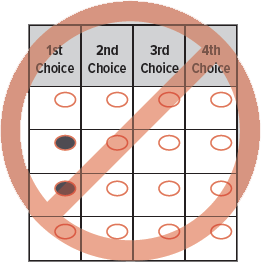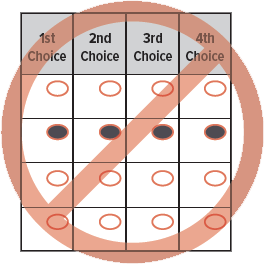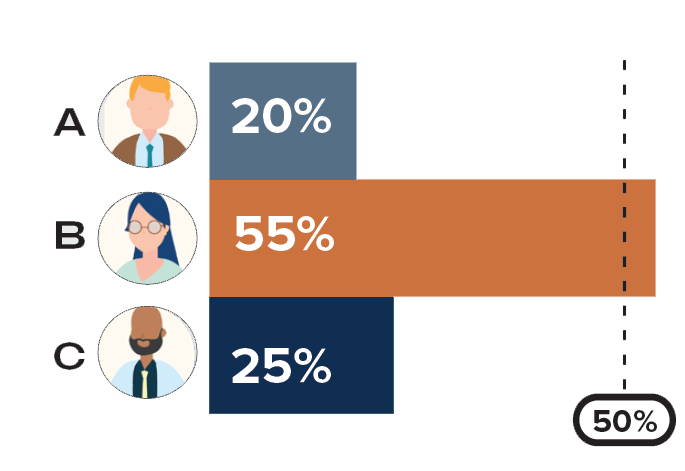Ranked-Choice Voting
RANKED-CHOICE VOTING INFORMATION
Ranked-choice voting (also known as instant-runoff voting) allows voters to rank up to five candidates for a single office in order of preference. This system enables the election of local officials by majority vote without requiring a separate runoff election.
Voters in Albany, Berkeley, Oakland, and San Leandro will use ranked-choice voting to elect most local officials. However, ranked-choice voting does not apply to the election of county, state, or federal officials, nor does it affect the approval or rejection of ballot measures.
MARKING YOUR RANKED-CHOICE VOTING BALLOT
On the ballot, a ranked-choice contest is displayed as a grid, with candidates listed in the leftmost column and ranking choices indicated across the top row.
To cast your vote, start ranking your chioces on the left side, fill in one oval per column.
- Mark the 1st column for your 1st choice candidate
- Mark the 2nd column for your 2nd choice candidate
- Mark the 3rd column for your 3rd choice candidate, and so on...
To vote for a qualified write-in candiate*, write the name of the candidate in the space at the end of the candidate list and fill in the oval for the rank.

*A qualified write-in candidate is a person who has submitted the required documentation to run for office after the ballots were printed. A list of qualified write-in candidates (if any) will be available at acvote.alamedacountyca.gov and the Registrar of Voters’ office as well as all Vote Centers.
RANKING TIPS
You can rank as many candidates as you like, up to 5.
 |
 |
 |
| Rank candidates in your order of choice. | Mark no more than 1 oval in a column. We will not be able to count either vote. | Mark no more than 1 oval in a row. We will only be able to count your first ranking. All others will not count. |
HOW RANKED-CHOICE VOTING CONTESTS ARE COUNTED
We begin by counting all first-choice votes. If any candidate received a majority of votes (50% + 1 vote), that candidate wins.

Candidate B is the winner because Candidate B received a majority of votes (55%).
WHAT IF NO CANDIDATE RECEIVED A MAJORITY OF FIRST-CHOICE VOTES?
We eliminate the candidate with the lowest number of votes. If you voted for the eliminated candidate, your vote moves to your second choice. The candidate in last place (Candidate A) is eliminated. Voters who chose Candidate A as their first choice will have their vote moved to their second choice.

We count the votes again. If a candidate now has a majority of votes, that candidate wins. The votes are counted again. Candidate C is now the winner because Candidate C has a majority of votes.

WHAT IF THERE IS STILL NO WINNER (NO CANDIDATE HAS A MAJORITY)?
The process of eliminating the candidate(s) with the lowest number of votes continues until a candidate has a majority.
Need to Request a New Ballot? If you make a mistake while marking your ballot, you can request a new ballot by calling (510) 272-6973, or asking an Election Worker or Vote Center representative.






